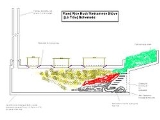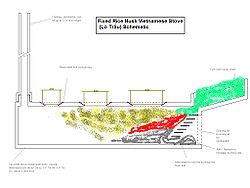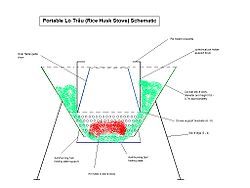
Lo Trau
Encyclopedia

Cook stove
In cooking, a cook stove is a very basic stove heated by burning wood, charcoal, animal dung or crop residue. Cook stoves are the most common way of cooking and heating food in developing countries....
used in Vietnam
Vietnam
Vietnam – sometimes spelled Viet Nam , officially the Socialist Republic of Vietnam – is the easternmost country on the Indochina Peninsula in Southeast Asia. It is bordered by China to the north, Laos to the northwest, Cambodia to the southwest, and the South China Sea –...
since the 1950s.
Etymology
The name Lo Trau (Lò Trấu in VietnameseVietnamese language
Vietnamese is the national and official language of Vietnam. It is the mother tongue of 86% of Vietnam's population, and of about three million overseas Vietnamese. It is also spoken as a second language by many ethnic minorities of Vietnam...
comes from the words of Lò (stove) and Trấu (rice husk).
History and design
The timeline of the development of the Lo Trau is unclear, however it is known that the Lo Trau has been in use in Vietnam at least since the 1950s. The fixed version Lo Trau stove is thought to be strongly related to the Castrol stove design of the architectArchitect
An architect is a person trained in the planning, design and oversight of the construction of buildings. To practice architecture means to offer or render services in connection with the design and construction of a building, or group of buildings and the space within the site surrounding the...
François de Cuvilliés
François de Cuvilliés
François de Cuvilliés was a Belgian-born Bavarian decorative designer and architect who was instrumental in bringing the Rococo style to the Wittelsbach court at Munich and to Central Europe in general.Cuvilliés was so diminutive in stature that it was as a court dwarf he first came to the notice...
in 1735 and similar European designs in the 1830s, with flue pipes connected to the chimney, oven holes into which concentric iron rings on which the pots were placed. Depending on the size of the pot or the heat needed, one could remove the inner rings. A recent innovation is the portable Lo Trau. Its compact design and efficient operation has been the target of a number of studies.
Recently it has been distributed in the Negros area of the Philippines in the The Southern Negros Sustainable Agriculture Demonstration Projects in the 1990s . This relatively late uptake of apparently long-used innovation means the potential of rice husk as fuel has been overlooked by many for a long time, as well as the obscurity of the Lo Trau designs to the wider world.

Operation
The stove is started by burning easily ignited material such as bundle of coconut leaves, newspaper partially embedded in the rice husks or other fuels in the combustion chamber area. After the fire is established, the updraft air from the stove designs will quickly sustain and magnify the combustion. The rate of combustion is regulated by removing appropriate amount of ash from under the combustion area with a poker, thus enable more fuel to enter.Fuel
Contrary to the name, the Lo Trau is quite versatile. It can burn wood chips, saw dust, small branches, small logs (with reduced heat controlling ability) and leaves.Efficiency
Open fire has four major disadvantages: It is dangerous, it produces much smoke, soot blackens the cookware, and the heat efficiency is poor. The enclosed design of the Lo Trau means complete combustion of the fuel, better use of the heat that it generated and thus reduce the fuel consumption by its furnace-like burning generated by the updraft through the chimney. Due to its furnace-like operation, most fuel will burned thoroughly into fine ashes with almost no waste. In situ test findings showed that it took only 5 minutes to boil water using an approximate 180g of rice husk. This figure is impressive when compared to liquefied petroleum gas (LPG), fuel wood, and charcoal stoves, which required 5, 15, and 20 minutes respectively to boil the same amount of water. It should also be noted that at the present time both wood and charcoal fires are frequently ignited using kerosene, a cost that would be eliminated with the rice husk stove.External links
- http://www.bioenergylists.org/stovesdoc/IRRI/Lotrau/Lotrau.html
- http://www.bioenergylists.org/stovesdoc/IRRI/Lotrau/Lotrau.html%3Cbr%20/%3E
- http://www.practicalaction.org/practicalanswers/product_info.php?products_id=224
- http://www.fao.org/inpho/content/documents/vlibrary/AE617e/65.htm

